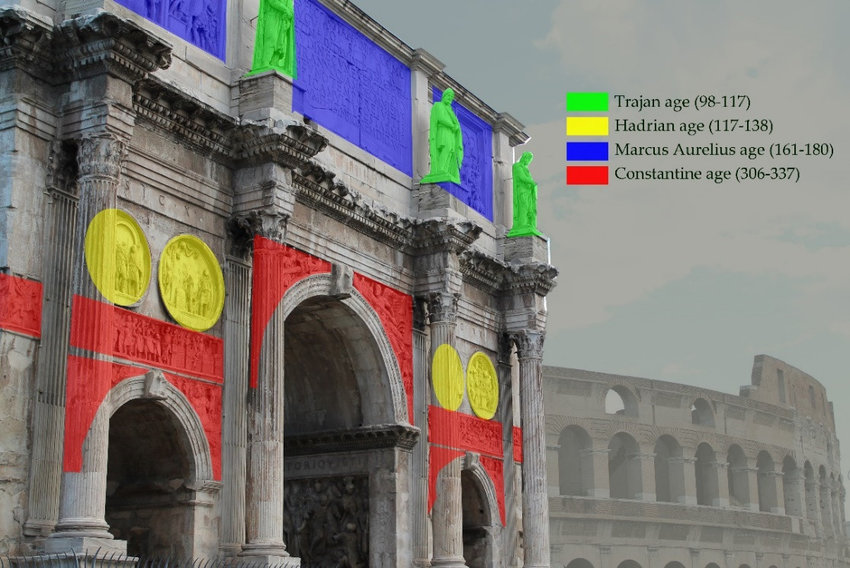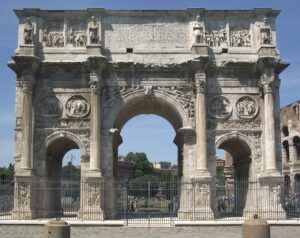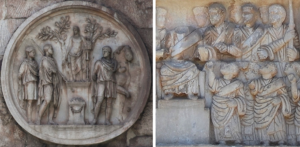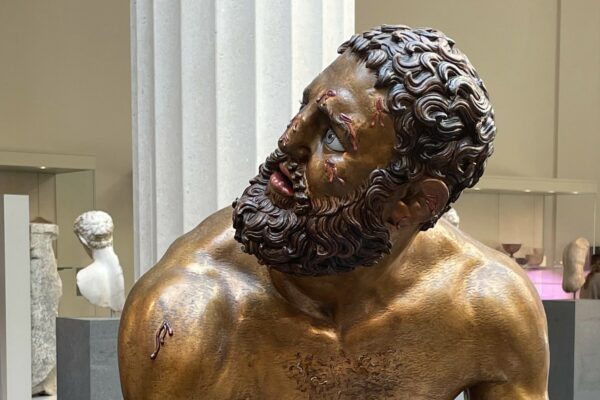
This post was written by student Bailey Evans, as part of her Spring 2024 Honors Project in CLAS-C 414 Art and Archaeology of the Roman World. More about Bailey at the end of the post.
Let me preface this post by saying that I would never promote stealing.
However, the Romans really seemed to exemplify what it means to take what’s not yours. They would even take this crime a step further and display their pillage for all Romans to bear witness.
Sometimes this would be done as a means to promote an Emperor, or to emphasize the strength of the military. Sometimes it was done simply because a Roman structure could do with an additional column, and they could snatch it from somewhere else.
The use of spolia was instrumental in creating the art and architecture of Ancient Rome that academics continue to study to this day. It allows us a deeper look at how Roman society valued art, but also the way in which artistic ideas were ‘shared’ between cultures, whether intentionally or not.
I have personally learned about the use of spolia in every single Classical Studies course I’ve taken, but each one offers a new perspective on the act. Each course also offers new examples which help to see exactly how important art and architecture were for ancient societies.
A strong example of the use of spolia as a means to emphasize political status was in the Arch of Constantine which was a triumphal monument created to honor the emperor. This arch was located in Rome, between the Flavian Amphitheater and the Temple of Venus and Roma, which meant that it was highly visible to Roman people going about their day to day lives.
Arch of Constantine, 312-315 CE, incorporating older spolia, Rome. Photo: SmartHistory.org
The arch is large, towering over everyone who visits it, and has some elements that were originally created for this triumph. For example, an inscription proclaiming the greatness and divinity of Constantine while boasting of his prominent military strength.
However, a great deal of the key elements were constructed under the reign of previous emperors.
In a multitude of different styles are relief sculptures that were likely taken from older monuments throughout the Roman Empire. While our modern academics are unable to confirm the origins of these artworks, they are able to note the imperial styles that are immortalized.
Trajan. Hadrian. Marcus Aurelius.
Sculptures from Trajan’s time as Emperor of Rome are located on the top of the decorative columns. They’re large and imposing, showing captive Dacians from when Trajan completed his own triumph and defended Rome against invaders. The dedication inscription carved to honor Constantine is located in between two of the sculptures.
Artwork from the reign of Hadrian is prominent in the middle register. The figures in these roundels are more naturalistic, which is reminiscent of Ancient Greek and Roman artistic tradition. When placed directly beside reliefs from Constantine’s own reign, where the figures are blockier and more abstract, the difference in stylization is very clear.
Two reliefs from the Arch of Constantine: left: Sacrifice to Apollo, Hadrianic, c. 117-138 CE; right: detail, Distribution of Public Gifts, era of Constantine, 312-315 CE. Photo: SmartHistory.org
The large panel reliefs located at the top of the arch can be attributed to Marcus Aurelius, who ruled from 161 to 180 CE. These panels were likely taken from a triumphal monument constructed in Aurelius’ honor regarding his defeat of the Marcomanni and the Sarmatians.
One of the themes that is present across the artworks of all three of these past emperors was the importance of Roman tradition.
There are depictions of sacrifices to the gods, political leaders speaking with the military, and Roman strength in the form of military conquest.
So, while these emperors are no longer in power, and at the point in time in which Constantine was in control hadn’t been for a while, their artworks and their successes are still on display for all of Roman society to bask in.
And right beside the work of these great emperors is Constantine’s own displays of triumph and strength.
The construction of the Arch of Constantine was riddled with spolia, but each separate ‘borrowed’ piece was a means to further elevate the status of the current reigning emperor, Constantine.
It was very intentional to incorporate works from these different eras of Roman rule as Trajan, Hadrian, and Marcus Aurelius were considered three of the ‘Five Good Emperors.’ By placing Constantine directly beside the rulers that were considered to be the best, his own reign is defended and permanently connected to their legacy.
While the Arch of Constantine does reflect the ideals of previous Roman society through the designs in the spolia sections, the newer elements begin to represent the shift in religious and cultural beliefs in the Empire. Constantine’s inscription, where he remarks on the divinity that graced him with power, is left purposefully ambiguous. This left room for Roman people to believe Constantine was thanking the ancient Roman deities or the God of the Christian faith, depending on what religion they felt more aligned.
This was nowhere near the only use of spolia in Ancient Rome, but it is one of the times when it was most notably used for a clear purpose.
Constantine made use of spolia in order to emphasize his connection to Roman history and power, while simultaneously promoting his adjusted beliefs to begin the transition into what we now consider the Byzantine Empire.
While the Ancient Roman Empire is no longer standing, the Arch of Constantine remains tall and imposing in Italy, allowing modern scholars to continue to dissect the artworks and stylizations to this day.
There will always be a loss of context when a monument or relief statue is taken from its original creation point and placed somewhere else. However, in the case of Roman spolia, we gain a deeper understanding of Roman culture and political power structures.
We are also given the chance to see beautiful and important art pieces that may not have survived in their original home.
Maybe stealing is fine on some occasions.
Bailey Evans is an IU-Indy student pursuing many interests: a major in English with a concentration in literature; an Individualized Major in Classical Studies; and minors in Art History and Creative Writing. She has a deep love for how Classical Studies provides a connection between the past and the present, especially through literature and art. She wrote this piece as part of her Honors Project for CLAS-C 414 Art and Archaeology of the Roman World. If you are interested in doing an honors project in a Classical Studies course, or in earning a Classical Studies Minor, please reach out to the Program Director Dr. Elizabeth Thill.




